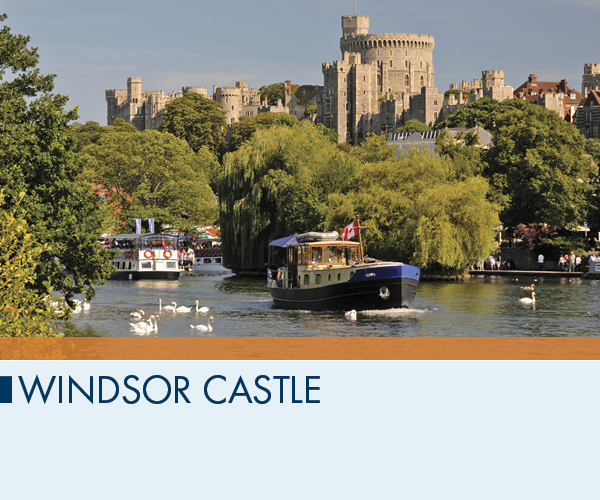
Previous Chapter | Next Chapter | Table of Contents
Exploring Windsor Castle | Where to Eat in Windsor Castle
24 miles (39 km) west of London.
The tall turrets of Windsor Castle, believed to be the world’s largest inhabited castle, can be seen for miles around. The grand stone building is the star attraction in this quiet town with some remaining medieval elements—though Eton College, England’s most famous public school, is also just a lovely walk away across the Thames. The castle is the only royal residence to have been in continuous royal use since the days of William the Conqueror, who chose this site to build a timber stockade soon after his conquest of Britain in 1066. It was Edward III in the 1300s who really founded the castle: he built the Norman gateway, the great Round Tower, and the State Apartments. Charles II restored the State Apartments during the 1600s, and, during the 1820s George IV—with his mania for building—converted what was still essentially a medieval castle into the palace you see today.
Essentials
Visitor Information Windsor (01753/743900 | www.windsor.gov.uk).
Exploring Windsor Castle
The massive citadel of Windsor Castle occupies 13 acres, but the first part you notice on entering is the Round Tower, from the top of which the Standard is flown and at the base of which is the 11th-century Moat Garden. Passing under the portcullis at the Norman Gate, you reach the Upper Ward, the quadrangle containing the State Apartments—which you may tour—and the sovereign’s Private Apartments. Processions for foreign heads of state and other ceremonies take place here, as does the Changing of the Guard when the Queen is in residence. A short walk takes you to the Lower Ward, where the high point is the magnificent St. George’s Chapel, home of the Order of the Garter, the highest chivalric order in the land, founded in 1348 by Edward III. Ten sovereigns are buried in the chapel—a fantastic Perpendicular Gothic vision 230 feet long, complete with gargoyles, buttresses, banners, swords, and choir stalls. This is also where royal weddings take place.
The State Apartments are as grand as Buckingham Palace’s and have the added attraction of a few gems from the Queen’s vast art collection: choice canvases by Rubens, Rembrandt, Van Dyck, Gainsborough, Canaletto, and Holbein; da Vinci drawings; Gobelin tapestries; and lime-wood carvings by Grinling Gibbons. The entrance is through a grand hall holding cases crammed with precious china—some still used for royal banquets. Don’t miss the outsize suit of armor, made for Henry VIII, in the armory. Make sure you take in the magnificent views across to Windsor Great Park, which are the remains of a former royal hunting forest.
One unmissable treat is Queen Mary’s Dolls’ House, a 12:1 scale, seven-story palace with electricity, running water, and working elevators, designed in 1924 by Sir Edwin Lutyens. The detail is incredible—even the diminutive wine bottles hold the real thing. | Windsor Castle | SL4 1NJ | 020/7766–7304 tickets, 01753/831118 opening hrs | www.royalcollection.org.uk | £17 (£44.75 family ticket) for Precincts, State Apartments, Gallery, St. George’s Chapel, Albert Memorial Chapel, and Queen Mary’s Dolls’ House; £9.30 when State Apartments are closed | Mar.–Oct., daily 9:45–5:15, last admission at 4; Nov.–Feb., daily 9:45–4:15, last admission at 3; St. George’s Chapel closed Sun. except to worshippers. Hrs vary; check website.
The splendid redbrick Tudor-style buildings of Eton College, founded in 1440 by King Henry VI, border the north end of High Street. During the college semesters, schoolboys dress in their distinctive striped trousers, swallow-tailed coats, and stiff collars to walk to class—it’s all terrifically photogenic. The Gothic Chapel rivals St. George’s at Windsor in size and magnificence, and is both austere and intimate. The Museum of Eton Life has displays on the school’s history. Admission to the school during term time is with a prebooked guided tour for groups of at least 14 (no children) only, but there are also public tours during school holidays for individuals that don’t require prebooking and are open to children. | Main entrance off Eton High St. | SL4 6DW | 01753/671177 | www.etoncollege.com | £7 short tour, £10.50 extended tour | Tours mid-Mar.–Oct., Wed.–Fri., weekends at 2 and 3:15. Guided tours mid-Mar.–Oct., daily 10:30–4:30. During term time (Nov.–Feb.) Wed.–Fri., weekends after 1:30. Check website for details.
Where to Eat in Windsor Castle
Two Brewers.
$ | BRITISH | Two small, low-ceiling rooms make up this 17th-century pub where locals congregate and palace staff unwind after work. Children are not welcome, but adults will find a suitable collection of wine, espresso, and local beer, plus an excellent little tapas-only menu. On Sunday the pub serves a traditional roast. With only nine tables, reservations are essential. | 34 Park St. | SL4
1BD | 01753/855426 | Closed Fri. and Sat. evenings.
Previous Chapter | Beginning of Chapter | Next Chapter | Table of Contents